In the 18th century Lower Street was called Frog Street, probably because of the open stream that ran along the west side of the road. The stream comes from Moberley Pond, above St Lawrence Church, and passes through the village to the River Frome at Barrow Farm. It has been covered in for many years and runs in a culvert under the pavement, gardens and houses along Lower Street.
The map below shows the enclosed culvert (black dashed line), following Lower Street for much of its length. The picture on the right shows the culvert itself and the timbers which had been used for many years to enclose it. The timbers were replaced in 2023 as part of a drainage improvement project (see the section on “Natural Environment”).
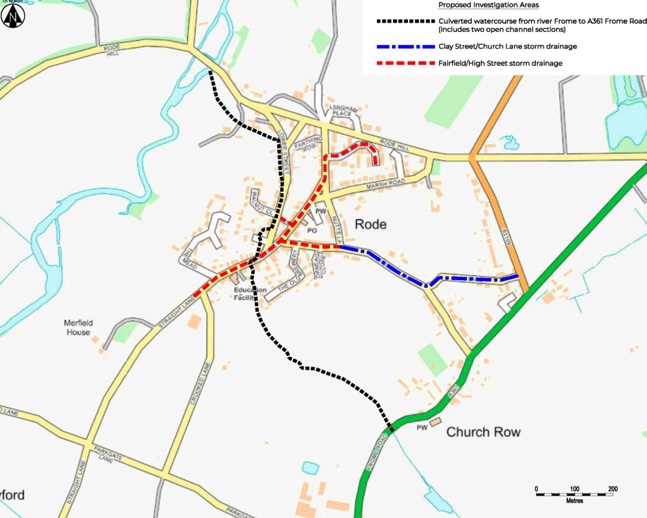
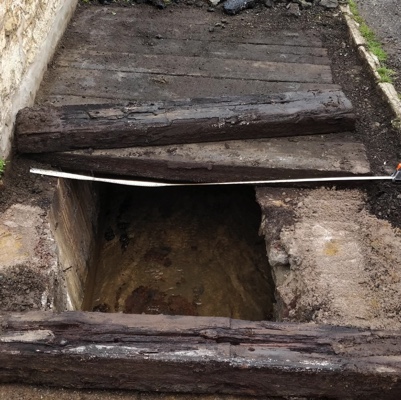
1 Lower Street was originally built in the 17th century and in times gone by it had various usages. Apparently it was known by locals as the Apprentice Cottages – maybe a hold-over from the time when Mr. Freeman owned the tailor & draper shop opposite at the end of the 1870s. In this century it was a shop and house but now it is used as a residence.
Silcocks’ Hall is the building attached to the cottage at 2 Lower Street. It is located behind the two Silcocks’ built houses on the High Street (27 & 29). It has a date stone of 1868 above the door. According to the Kelly’s Directories of the time, it was built by Edward Silcocks to hold about 200 persons and he granted the use of it free to the village for entertainments. See: https://www.rodevillage.com/history-of-rode/schools-and-halls/silcocks-hall/
4, 6, 8 and 10 Lower Street are a cluster of cottages arranged around a courtyard. On the 1806 map there was only an uninhabited structure shown here. An abstract of title dated 1825 indicates that this area was called Catherine Mark and four new cottages were erected c1815 by John Wilson. He died in 1821 and his son James mortgaged these and other properties with John Wheeler for £150. At that time widow Elizabeth Wilson, Mary Wilson and James Wilson were living in three of the cottages. By 1843 the cottages were owned by Hannah Silcox. She lived in the second one from the Big Shard and the property consisted of the house, carpenter shop and yard. On the corner of Lower Street and the Big Shard, there is an outbuilding or shed which was a blacksmith’s shop in the 1920s and 1930s owned by a Frank Kemp, who lived in 6 Lower Street which used to be called Rose Cottage. Mr. Kemp owned at least six cottages in Lower Street. The blacksmith’s shop was not shown on the 1843 map but it was there by 1904.
A description from an indenture dated 1835 states: “3 houses in Road in the parish of North Bradley, Wilts on the eastern side of Lower St. One house, formerly consisted of 2 houses, having 2 rooms on the ground floor called the parlour and the kitchen. Plus a shop with a schoolroom over and a courtyard all situate in front of the houses”
From the Road Hill tithe apportionment of 1843: “A terrace of 6 houses, the 4 to the north owned by Hannah SILCOCKS and 2 to the south by Anne WHEELER”
From an indenture dated 1870: “The shop with schoolroom over was being used as a blacksmith’s shop with ware room over.”
From an indenture dated 1957: “The former schoolroom is shown to the south of the former blacksmith’s shop.”
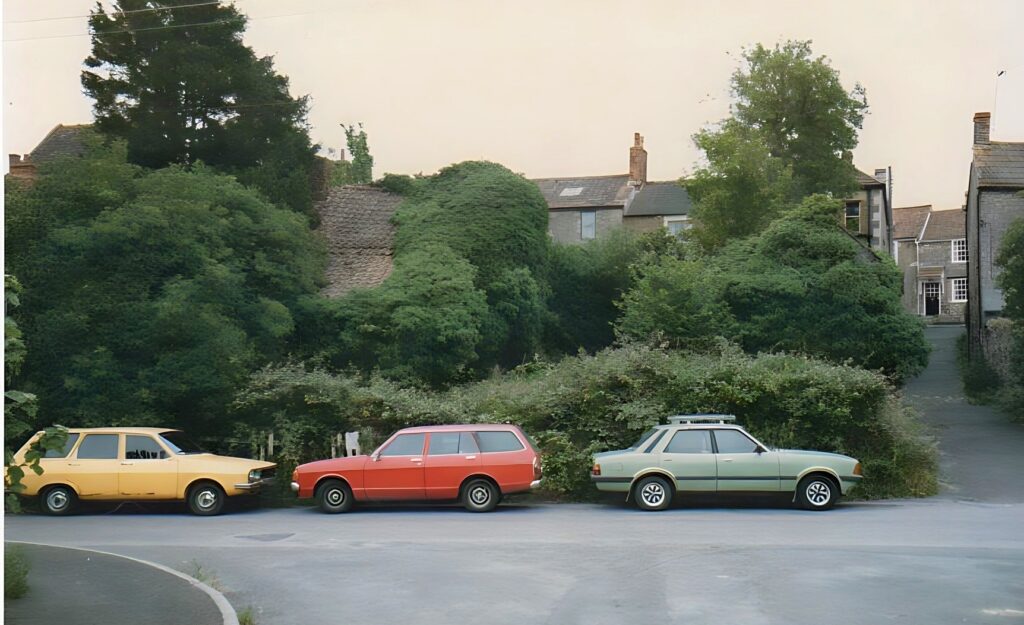
12 Lower Street (Chelsea Villa) was built around the year 1820 and it has retained some of its 19th century features. (Shown in red in figure 33). The house was probably built for James Daniell, who died in 1825, as his executors sold it to Thomas Walker Langley in 1839. (Langley was the relieving officer and registrar of births and deaths for the Rode district). He died in 1867 and his heirs eventually sold the house to John Tilt Noad in 1880. He was a butcher and he converted the outbuildings to a slaughterhouse and shop. He lived at Chelsea Villa until he died on 27 July 1883.
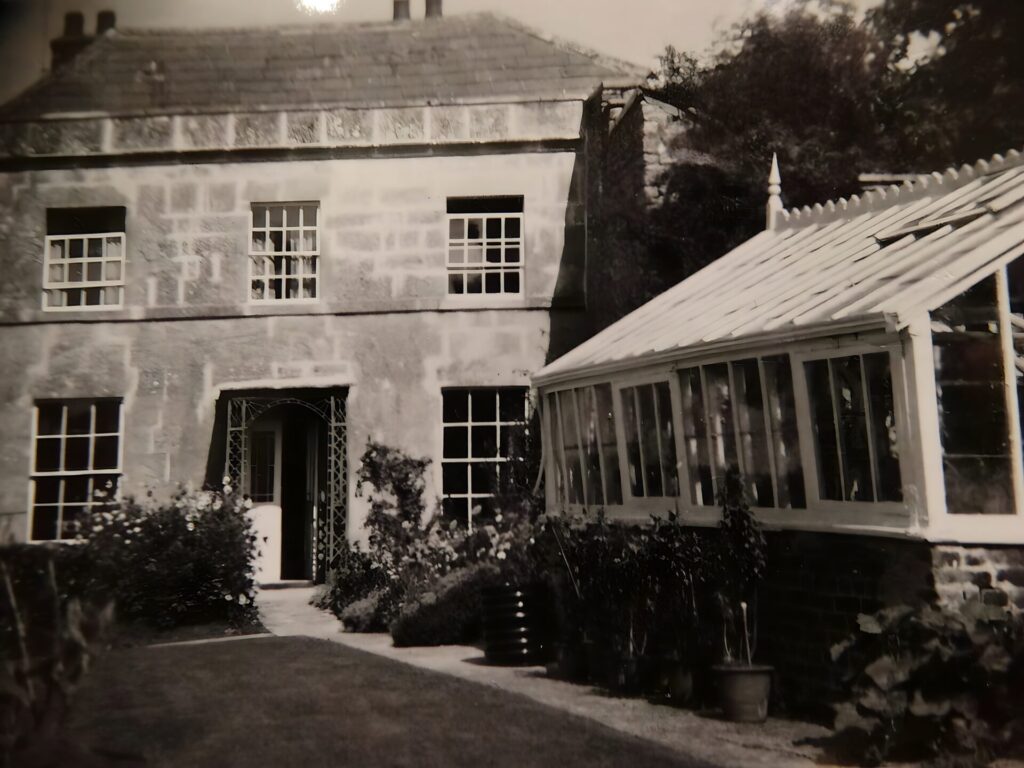
The Kelly’s Directory for 1885 lists Henry Noad, his son, living at Chelsea Villa. In January 1894, the property, which was occupied by John Noad, was put up for sale and purchased by Tom Noad for £310. By 1903, Chelsea Villa was lived in by Rowland Kington, butcher. Paul Stacey remembered that the slaughterhouse was located behind the large doors of the outbuildings still fronting onLower Street today. The butcher shop was located behind the window on the right of the slaughterhouse.
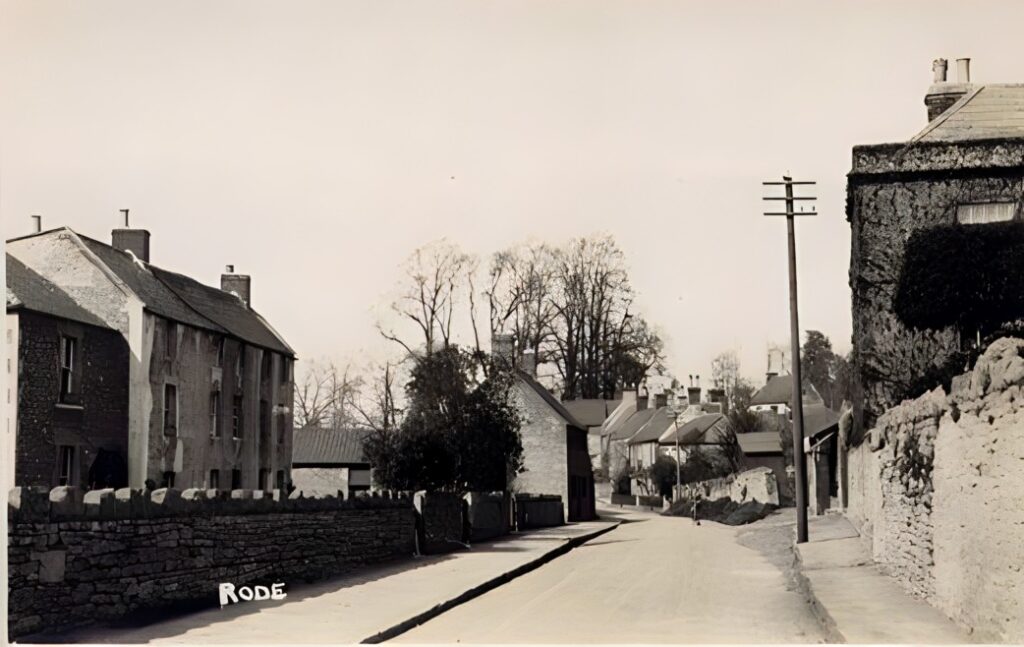
16 Lower Street (Sheriffhales) is a mid 18th century house, formerly called Australia House. (Shown in purple in figure 33. See also figure 35 for an earlier map). In 1843, it was owned and occupied by George Osborne. By 1885 John Craddock was living here and in 1889 when it was still called Australia House, it was lived in by Mrs. Noad with her daughter, Mary Cray and family. Jane was the widow of John Noad and had been living next door in no. 18. By 1907 John Read had renamed it The Nook, in 1923 Miss Grimston called it Rodesyde, in 1949 Frederick Ensor changed its name again, to Lower House and in 1949 Gwendolyne Icke called it Sheriffhales. At one time, like at many other addresses in the village, you could go from 16 Lower Street into 18 Lower Street from the attic rooms.
17 Lower Street (Rock Cottage)
[Extract from “History of Some of the Old Buildings in Rode” by Dawna Pine, second edition]:
17 Lower Street is a late 17th century structure with a former central door opening now blocked by a 20th century 2-light casement in a plain stone surround. The iron bracket which projects from the first floor once held an oil lamp and it is one of the few remaining ones in the village. The lamp has recently been put back up. (There is another iron bracket for an oil lamp on the front of the Methodist Chapel now used for an antique furniture shop). May Woolley said that her brother, Herbert, was a lamplighter of these oil lamps. In the winter he went out every night to light them and then he went back at 10:30 to put them out. The lamps in the village were never lit again after the First World War and there was no electricity in the village until 1938. So, at night the streets must have been very dark indeed.
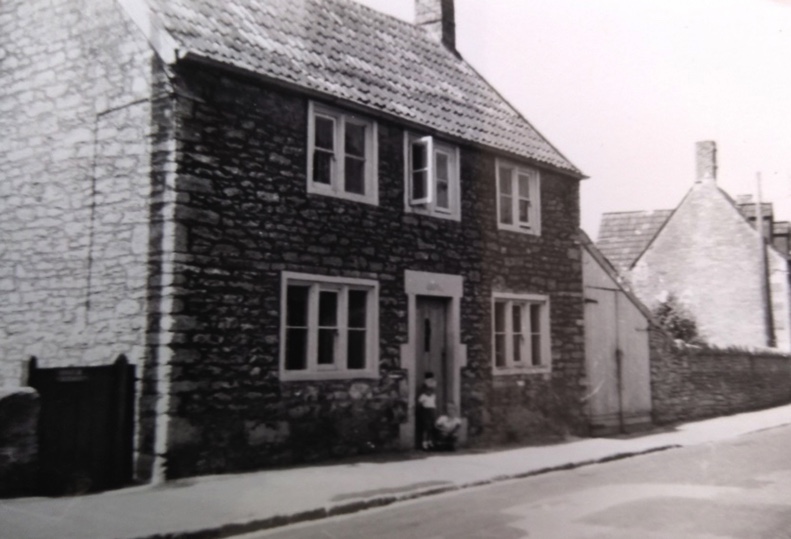
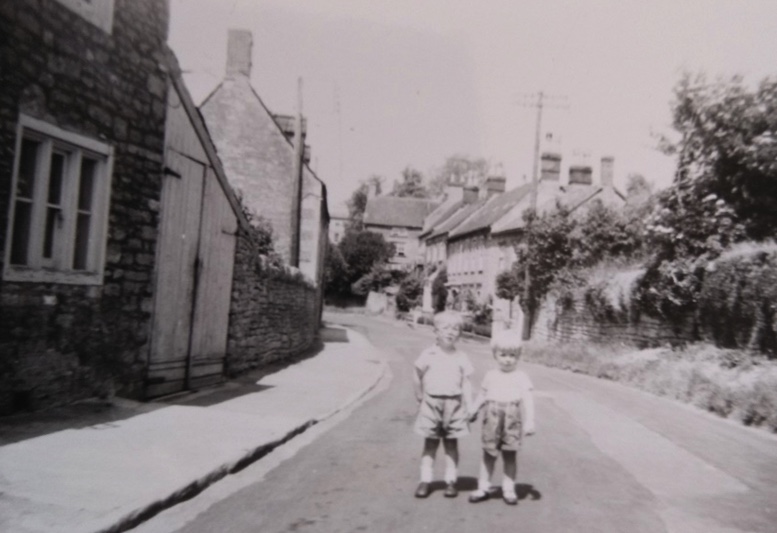
18 Lower Street (Bellsburn). In 1843, the property was owned by George Osborne, occupied by Henry Osborne and consisted of house, bakehouse, outbuildings, yard and garden. The Tithe Map shows that the property had a long extension into the garden on the left side. In 1880 John Noad, of independent means was living here – not to be confused with John Tilt Noad at Chelsea Villa. He died in 1886 and left the house to his son, Joseph, who died two years later. In 1899 Joseph’s widow, Cecilia, married her brother-in-law Samuel Haskell, who ran a shop here. Cecilia’s son Henry Noad continued with a grocery and hardware shop for a while before he died in the First World War and then his widow Gertrude took over. By 1904, further extensions had been made to the back of the property; however, by 1924, the shape of the house was as it is seen today.
The large attic has a fireplace but the owner said that the floor did not look as if it would be the original one. In the 1930s the shop was a general store, had a bay window in the front of the property and it was run by the Heath family. Edwina Davis said that she used to go there as a child for an ice cream which was really home-made custard. On May 11th, 1948, there were terrible floods in the village. The Gordons who were living in the house were just able to get out in time. Mrs. Gordon and her daughter Rosanne had just had tea when the storm broke. They heard a loud roar and a huge wave of water smashed in through the back of the house, filling it to a depth of seven feet. The sheer weight of the water flung the front door, lintels and posts across the road and on to the railings of a garden on the opposite side. Much of the furniture and fittings in the downstairs rooms were completely destroyed. Surrounding cottages also were similarly damaged. Mr. P. J. Fussell later said the rainfall was 2” in a half hour and 4” altogether.
20 Lower Street (Nundah Cottage) is an 18th century house. In 1843, Thomas Fussell owned the house, shop and garden here. On the 1904 map, the property had been divided into two small cottages but the 1924 map again shows it as one. Mrs. Fisher lived here from at least 1931 to 1935.
22 Lower Street is now a part of Nundah Cottage, which is next to it. There is a tablet on the front of the house with “G O 1801” carved into it. In 1843, the house was owned by George Osborne and occupied by William Freeman.
21 Lower Street (Overbrook). This is a 17th century building with two 19th century gabled dormers. It was originally one dwelling and then at some time it was divided into two and there was an addition made at one end to make a shop. At one time or another there was a hat shop, a shoemaker and a sweet shop at this property. There is a round house at the back which some think may have been a cock-fighting pit and was later used as a laundry. It shows up on the 1886 map. The house had been divided into two dwellings by then.
When the Gayers bought the property in 1974, they again combined the two cottages to make them into one house. They also found some old clay pipes and a supply of poppy seeds under the attic floor boards.
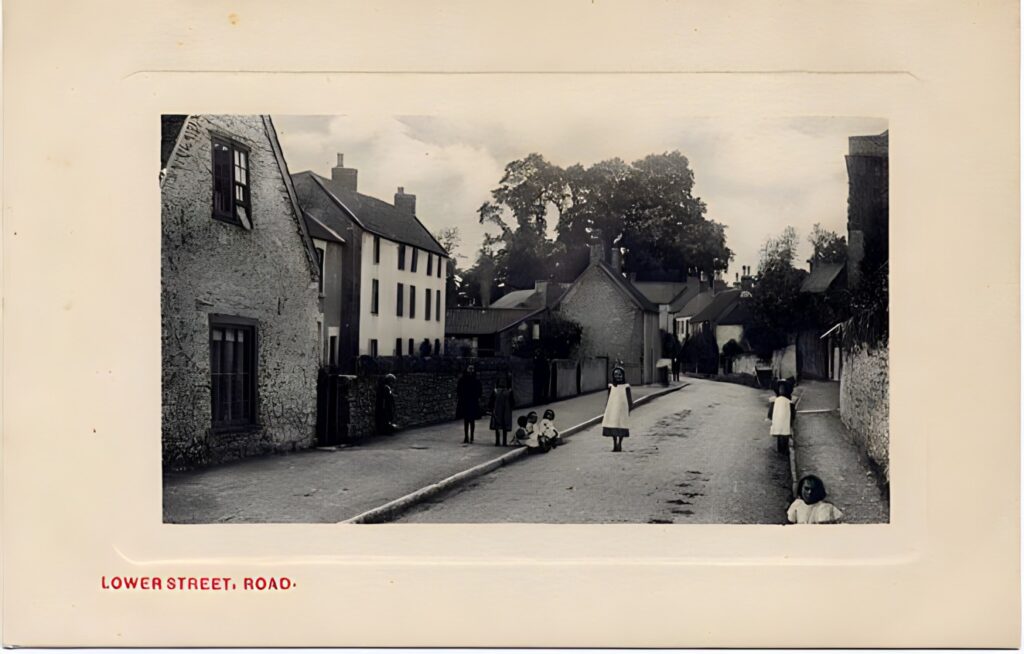
24 Lower Street. This area in Lower Street where it connects with Halfpenny Lane and Farthing Row, was once called “The Batch”. A house is shown here on the 1792 map. The property may have been a village alehouse at one time, called the Beehive. The garden room in the present house is new, but as you can see from the map in figure 33, there was originally an old cottage here. Conservation officers suggest that this part of Lower Street, along with the Green and the part of High Street near the Jubilee Clock at one time were all market “triangles” in the village.
Extract from “A History of Brewing in Rode” by Sidney Fussell and Brian Foyston, 2006:
The Beehive: The evidence for this is rather sketchy but its site is said to be at the bottom of Farthing Row, where it gives on to Lower Street. Only recently, on being shown an old (but subsequently tinted) picture of this area and being asked what it was, a respected elderly villager immediately said “The Beehive”. He was pointing at No. 24 Lower St. The present owners’ deeds show that in 1962 Percy John Fussell of Mayfield House sold a Blacksmith’s shop “formerly in the Parish of Southwick”, an adjoining cottage with rear garden and “Beehive Cottage” situated at “the Batch” in Lower Street. The Batch is the patch of land in front of the present property and the Blacksmith’s Shop is now its conservatory. The current owner gave the modern name of “Batch Cottage” after his purchase of it in 1973, and “Beehive Cottage” itself had also in the past been called both “Meadow View” and “Touch Down”. Incidentally its namesake at Abingdon in Berkshire carries the following words on its sign: “Within this hive, we’re all alive, Good liquor makes us funny! If you are dry, step in and try The flavour of our honey!”
(Referring perhaps to the use of honey for brewing in earlier days).
25 Lower Street (Brook House) is an early 19th century house (shown in royal blue in figure 33). Paul Stacey said it has been modernised by Edward Silcocks. It has at least one Silcocks’ window (he sometimes would use little partial windows) and the canopy over the door is probably also by Silcocks. North of the house is the mid-18th century stable and coach house with “A” frame roof. In the 1930s there were stone steps up to a small door. There is an early 19th century shop front on the left side of the house.
There was a baker’s shop here in 1839, owned by George Osborne and run by James Morgan. Morgan was also a parish constable and first on the scene of the murder at Langham House. By the early 1900s Morgan’s great nephew-in-law, William Towsey, ran the shop as well as lived here. Paul Stacey remembered Mr. Towsey saying that he slept with his head in Wiltshire and his feet in Somerset, because at that time the county border ran through the middle of his house. According to Brian Foyston, in the 1890s Mr. Towsey sailed before the mast round Cape Horn; he was successively a sailor, farmer, builder and grocer. It is also said that when he was nearly 91 years old, Mr. Towsey cut the hedge above the chapel wall next to the P.O. from a ladder.
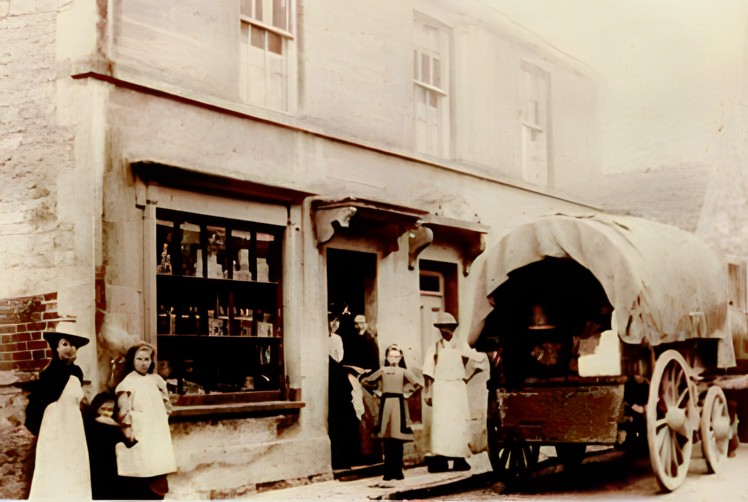
27 to 31 Lower Street. This terrace of cottages appears on the 1792 map. In 1806 no. 27 was owned by Job Tucker and occupied by Josh Daniells; and the other two were owned by T. W. Ledyard. By 1843 no. 27 was in the hands of Job Tucker’s executors. It had been converted into two cottages occupied by Benjamin Hancock and Stephen Rossiter. Nos. 29 and 31 had been bought by John Fussell and were occupied by Richard Quance and William Wilkins.